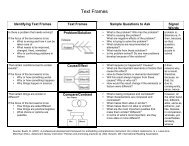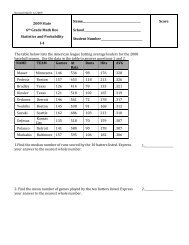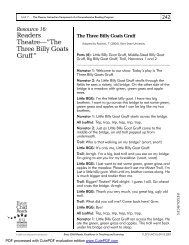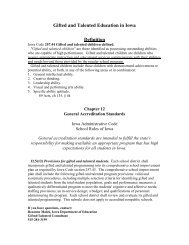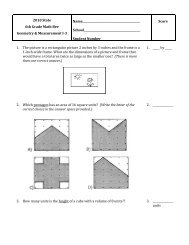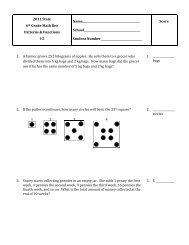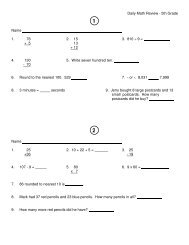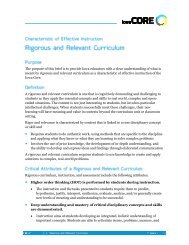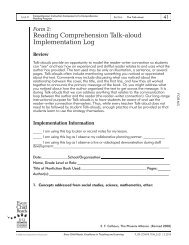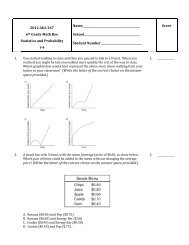Do parents make a difference to children's academic ... - Aea 267
Do parents make a difference to children's academic ... - Aea 267
Do parents make a difference to children's academic ... - Aea 267
You also want an ePaper? Increase the reach of your titles
YUMPU automatically turns print PDFs into web optimized ePapers that Google loves.
Family fac<strong>to</strong>rs and <strong>academic</strong> achievement 443followed by their ‘Desired level of education’. ‘Length of time’ and ‘Push for highachievement’ were, similarly, moderately correlated with ENTER scores. The size ofthese correlations ranged from 0.0 <strong>to</strong> 0.48. ‘Interest in schooling’ and ‘Satisfactionwith education’ were very weakly related with ENTER scores, but only the formercorrelation was significant.All variables showing statistically significant <strong>difference</strong>s between parent groupsaccording <strong>to</strong> ANOVAs were entered on <strong>to</strong> an SPSS 11.0 data sheet <strong>to</strong> investigatewhich parent variables best predicted student achievement. Table 4 displays theunstandardized regression coefficients (B), the standardized regression coefficients(β) and adjusted R 2 . R for regression was significantly different from zero, (F(6, 461)= 25.09, p < 0.001). Only two of the independent variables contributed significantly<strong>to</strong> the prediction of student ENTER scores, with 24% of the overall varianceexplained by <strong>parents</strong>’ ‘Expectations of their child’s expected level of education’ andthe ‘Length of time’ <strong>parents</strong> had these expectations.Summary of responses <strong>to</strong> six open-ended questions posed <strong>to</strong> <strong>parents</strong>Parents of students in the high achieving group of schools chose their children’sschool for very different reasons <strong>to</strong> the other parent groups, with the former statingthat the religious education/culture, strong <strong>academic</strong> focus, small class sizes and goodteachers provided by the school were their priorities. In contrast, <strong>parents</strong> of themedium and low achieving schools were more interested in a more general, less<strong>academic</strong>, coeducational and well-located school that had good facilities andsurroundings. In all groups the majority of <strong>parents</strong> were happy with their choice ofschools and gave similar responses, mainly because their children were happy andbecause the school had met their expectations.When asked <strong>to</strong> explain their schools’ final-year results, <strong>parents</strong> of students in thehigh achieving group of schools were all fully aware of their schools’ results over pastyears, as well as the current year, and gave almost identical reasons for the results.Essentially, they described the results as excellent, and attributed them <strong>to</strong> the commitmen<strong>to</strong>f the teachers, high levels of student motivation and hard work, and <strong>to</strong> thefamilies’ and schools’ high expectations and pressuring of the students. In contrast,many <strong>parents</strong> of the medium and low achieving schools stated they ‘did not know’what the results were and said that final-year results were unimportant <strong>to</strong> them. Those<strong>parents</strong> of the medium achieving group of schools who were aware of the results statedthat they were either pleasing or average and this was due <strong>to</strong> teacher commitment.Table 4.Regression analysis summary for parent variables predicting student ENTER scoresVariable B βExpected level of education 55.82 1.00***Length of time had expectations 39.56 0.56**Note: Adjusted R 2 = 0.24 (N = 467, p < 0.001).
446 N. Jacobs and D. HarveyVCE results were unimportant <strong>to</strong> them. Responses <strong>to</strong> the open-ended questions showthat <strong>academic</strong>ally successful students have <strong>parents</strong> with high <strong>academic</strong> and careeraspirations for them and who provide the opportunity for the <strong>academic</strong> engagemen<strong>to</strong>f their children in family practices, such as discussion of current events and familyparticipation in cultural activities. These fac<strong>to</strong>rs suggest that although many studieshave demonstrated that students from low socio-economic and/or single-parent familiesare less likely <strong>to</strong> be <strong>academic</strong>ally successful than those from an opposite homeenvironment, <strong>parents</strong> can use family practices in many ways <strong>to</strong> mediate the negativeeffects of confounding variables. For example, low-income <strong>parents</strong> who are activelyinvolved in their children’s education and school may therefore be able <strong>to</strong> mediate thenegative effects associated with the lack of economic resources.This research was based on the traditional view of <strong>academic</strong> achievement in whichachievement scores (ENTER) were used for measuring school success. These scoreswere chosen as the preferred measure of <strong>academic</strong> achievement as ENTER scores areconsidered a nationally equivalent measure of school achievement (Vic<strong>to</strong>rian TertiaryAdmissions Centre, 1999). It was, however, recognized that there is much moreinvolved in school success than ENTER scores and that not all schools shared traditionalvalues about <strong>academic</strong> achievement. Most <strong>parents</strong> in the high achieving schoolsconsidered school success in terms of <strong>academic</strong> results (ENTER scores). On theother hand, many <strong>parents</strong> in medium and low achieving groups of schools supportedthe view of Gallup (1975, 1980) who believed school success is about students’ character,self-esteem and social development. An important question arising from thisresearch is the degree <strong>to</strong> which parental attitudes and expectations differ according <strong>to</strong>whether a school’s overall performance is considered outstanding or average in termsof <strong>academic</strong> success. More particularly, if schools can be identified as being consistentlyoutstanding in terms of <strong>academic</strong> results, is it also possible <strong>to</strong> identify <strong>difference</strong>sin parental attitudes and expectations with respect <strong>to</strong> <strong>academic</strong> outcomes?Future research would also benefit from investigating the generalizability of theseresults <strong>to</strong> <strong>parents</strong> of government school children and whether parent attitudes andexpectations vary according <strong>to</strong> the child’s gender.ReferencesAlexander, K. L., Entwisle, D. R. & Horsey, C. S. (1997) From first grade forward: early foundationsof high school dropout, Sociology of Education, 70, 87–107.Ama<strong>to</strong>, P. R. & Keith, B. (1991) Parental divorce and the well-being of children: a meta-analysis,Psychological Bulletin, 110, 26–46.As<strong>to</strong>ne, N. M. & McLanahan, S. S. (1991) Family structure, parental practices and high schoolcompletion, American Sociological Review, 56, 309–320.Bartlett, M. S. (1954) A note on the multiplying fac<strong>to</strong>rs for various chi square approximations,Journal of the Royal Statistical Society, 16(series B), 296–298.Bryant, F. B. (2000) Assessing the validity of measurement, in: L. G. Grimm & P. R. Yarnold (Eds)Reading and understanding more multivariate statistics (New York, American Psychological Association),99–146.Caldas, S. J. (1993) Reexamination of input and process fac<strong>to</strong>r effects on public school achievement,Journal of Educational Research, 86(4), 206–214.
Family fac<strong>to</strong>rs and <strong>academic</strong> achievement 447Cattell, R. B. (1966) The scree test for number of fac<strong>to</strong>rs, Multivariate Behavioural Research, 1,245–276.Cohen, J. (1988) Statistical power analysis for the behavioural sciences (Hillsdale, NJ, Erlbaum).<strong>Do</strong>wney, D. B. (1994) The school performance of children from single-mother and single-fatherfamilies, Journal of Family Issues, 5(1), 129–147.Entwisle, D. R. & Alexander, K. L. (1995) A parent’s economic shadow: family structure versusfamily resources as influences on early school achievement, Journal of Marriage and the Family,57(2), 399–409.Gallup, G. (1975) The seventh annual Gallup poll of public attitudes <strong>to</strong>ward public schools, PhiDelta Kappan, 57, 227–241.Gallup, G. (1980) The twelfth annual Gallup poll of public attitudes <strong>to</strong>ward public schools, PhiDelta Kappan, 62, 39.Heiss, J. (1996) Effects of African American family structure on school attitudes and performance,Social Problems, 43(3), 246–<strong>267</strong>.Kaiser, H. (1970) A second generation Little Jiffy, Psychometrika, 35, 401–415.Kaiser, H. (1974) An index of fac<strong>to</strong>rial simplicity, Psychometrika, 39, 31–36.Keeves, J. P. (1972) Educational environment and student achievement (Hawthorn, AustralianCouncil of Educational Research).Ma, X. (2001) Participation in advanced mathematics: do expectation and influence ofstudents, peers, teachers, and <strong>parents</strong> really matter? Contemporary Educational Psychology,26, 132–146.Marjoribanks, K. (1977) Socioeconomic status and its relation <strong>to</strong> cognitive performance as mediatedthrough the family environment, in: A. Oliverio (Ed) Genetics, environment and intelligence(Elsevier, North-Holland Biomedical Press), 385–403.Marjoribanks, K. (1994) Families, schools and children’s learning: a study of children’s learningenvironments, International Journal of Educational Research, 21(5), 439–552.Martini, M. (1995) Features of home environments associated with children’s school success,Early Child Development and Care, 111, 49–68.Neisser, U. (1986) New answers <strong>to</strong> an old question, in: U. Neisser (Ed.) The school achievement ofminority children: new perspectives (Hillsdale, NJ, Erlbaum), 1–17.Rumberger, R. W. (1995) Dropping out of middle school: a multilevel analysis of students andschools, American Educational Research Journal, 32, 583–625.Seginer, R. (1983) Parents’ educational expectations and children’s <strong>academic</strong> achievement: aliterature review, Merrill-Palmer Quarterly, 29, 1–23.Selden, R. (1990) Should test results be adjusted for socioeconomic <strong>difference</strong>s, SchoolAdministra<strong>to</strong>r, 47, 14–18.Steinberg, L., Lamborn, S. D., <strong>Do</strong>rnbusch, S. M. & Darling, N. (1992) Impact of parentingpractices on adolescent achievement: authoritative parenting, school involvement and encouragement<strong>to</strong> succeed, Child Development, 63, 1266–1281.Swick, K. J. & Duff, E. (1978) The parent–teacher bond. relating, responding, rewarding, (Dubuque,IA, Kendall/Hunt).Tabachnick, B. G. & Fidell, L. S. (2001) Using multivariate statistics (4th edn) (MA, USA, Allynand Bacon).Teachman, J. D. (1987) Family background, educational resources and educational attainment,American Sociological Review, 52, 548–557.Thurs<strong>to</strong>ne, L. L. (1947) Multiple fac<strong>to</strong>r analysis (Chicago, University of Chicago Press)Useem, E. L. (1992) Middle schools and maths groups: <strong>parents</strong>’ involvement in children’s placement,Sociology of Education, 65, 263–279.Vic<strong>to</strong>rian Tertiary Admissions Centre (1999) ENTER in<strong>to</strong> tertiary study, wheels in motion: a guide <strong>to</strong>the Equivalent National Tertiary Entrance Rank (Vic<strong>to</strong>ria, Information and Publishing Services,VTAC).
448 N. Jacobs and D. HarveyWalker, S. P., Grantham-McGregor, S. M., Himes, J. H., Williams, S. & Duff, E. M. (1998)School performance in adolescent Jamaican girls: associations with health, social and behaviouralcharacteristics and risk fac<strong>to</strong>rs for dropout, Journal of Adolescence, 21, 109–122.Williams, P. (1980) Adolescent identification and <strong>academic</strong> achievement: reporting the awarenessof similarity <strong>to</strong> role models, Journal of Youth and Adolescence, 9(4), 315–321.Wright, S. P., Horn, S. P. & Sanders, W. L. (1997) Teacher and classroom context effects onstudent achievement: implications for teacher evaluation, Journal of Personnel Evaluation inEducation, 11, 57–67.



